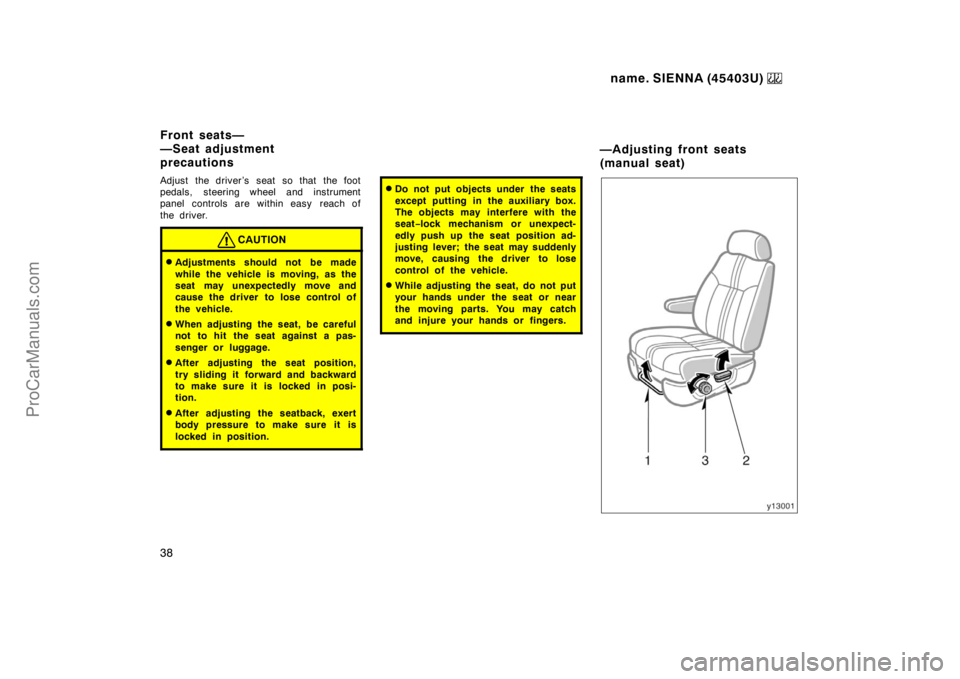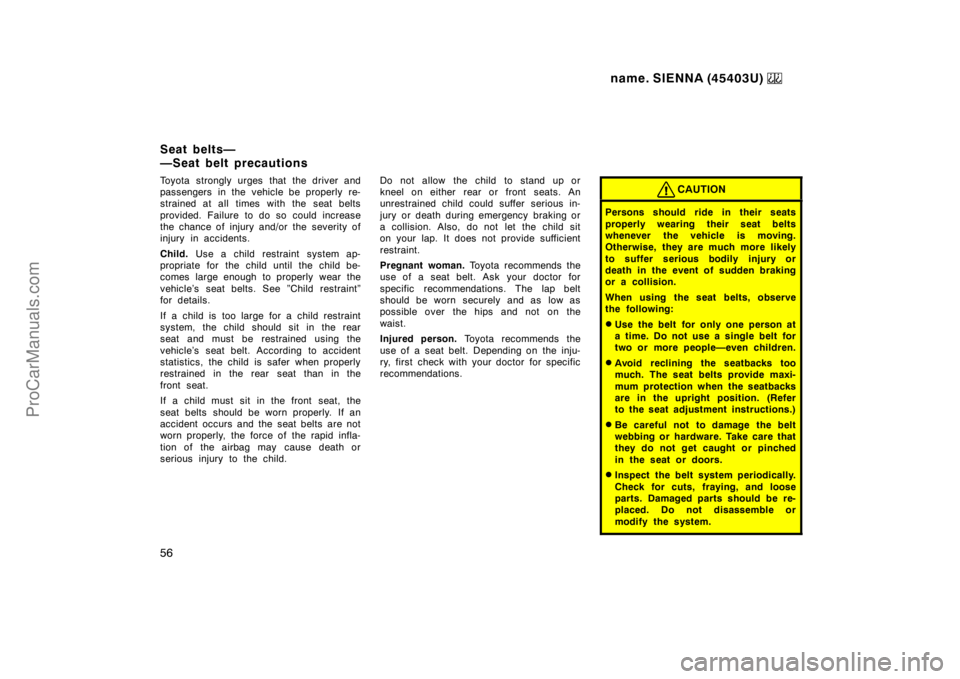Page 38 of 272

name. SIENNA (45403U)
38
Adjust the driver’s seat so that the foot
pedals, steering wheel and instrument
panel controls are within easy reach of
the driver.
CAUTION
�Adjustments should not be made
while the vehicle is moving, as the
seat may unexpectedly move and
cause the driver to lose control of
the vehicle.
�When adjusting the seat, be careful
not to hit the seat against a pas-
senger or luggage.
�After adjusting the seat position,
try sliding it forward and backward
to make sure it is locked in posi-
tion.
�After adjusting the seatback, exert
body pressure to make sure it is
locked in position.
�Do not put objects under the seats
except putting in the auxiliary box.
The objects may interfere with the
seat−lock mechanism or unexpect-
edly push up the seat position ad-
justing lever; the seat may suddenly
move, causing the driver to lose
control of the vehicle.
�While adjusting the seat, do not put
your hands under the seat or near
the moving parts. You may catch
and injure your hands or fingers.
Front seats—
—Seat adjustment
precautions—Adjusting front seats
(manual seat)
ProCarManuals.com
Page 55 of 272
name. SIENNA (45403U)
55
Head restraints
Ty p e A
Ty p e B
For your safety and comfort, adjust the
head restraint before driving.
To raise: Pull it up.
To lower: Push it down while pressing the
lock release button.
On some models, you can also move the
head restraint forward or backward. If
such adjustment is desired, pull or push
the head restraint.
The head restraint is most effective when
it is close to your head. Therefore, using
a cushion on the seatback is not recom-
mended.
CAUTION
�Adjust the center of the head re-
straint so that it is closest to the
top of your ears.
�After adjusting the head restraint,
make sure it is locked in position.
�Do not drive with the head re-
straints removed.
Armrests
To use the armrest, pull it down as
shown above.
NOTICE
To prevent damage to the armrest,
avoid putting heavy loads on it.
ProCarManuals.com
Page 56 of 272

name. SIENNA (45403U)
56
Toyota strongly urges that the driver and
passengers in the vehicle be properly re-
strained at all times with the seat belts
provided. Failure to do so could increase
the chance of injury and/or the severity of
injury in accidents.
Child. Use a child restraint system ap-
propriate for the child until the child be-
comes large enough to properly wear the
vehicle’s seat belts. See ”Child restraint”
for details.
If a child is too large for a child restraint
system, the child should sit in the rear
seat and must be restrained using the
vehicle’s seat belt. According to accident
statistics, the child is safer when properly
restrained in the rear seat than in the
front seat.
If a child must sit in the front seat, the
seat belts should be worn properly. If an
accident occurs and the seat belts are not
worn properly, the force of the rapid infla-
tion of the airbag may cause death or
serious injury to the child.Do not allow the child to stand up or
kneel on either rear or front seats. An
unrestrained child could suffer serious in-
jury or death during emergency braking or
a collision. Also, do not let the child sit
on your lap. It does not provide sufficient
restraint.
Pregnant woman. Toyota recommends the
use of a seat belt. Ask your doctor for
specific recommendations. The lap belt
should be worn securely and as low as
possible over the hips and not on the
waist.
Injured person. Toyota recommends the
use of a seat belt. Depending on the inju-
ry, first check with your doctor for specific
recommendations.CAUTION
Persons should ride in their seats
properly wearing their seat belts
whenever the vehicle is moving.
Otherwise, they are much more likely
to suffer serious bodily injury or
death in the event of sudden braking
or a collision.
When using the seat belts, observe
the following:
�Use the belt for only one person at
a time. Do not use a single belt for
two or more people—even children.
�Avoid reclining the seatbacks too
much. The seat belts provide maxi-
mum protection when the seatbacks
are in the upright position. (Refer
to the seat adjustment instructions.)
�Be careful not to damage the belt
webbing or hardware. Take care that
they do not get caught or pinched
in the seat or doors.
�Inspect the belt system periodically.
Check for cuts, fraying, and loose
parts. Damaged parts should be re-
placed. Do not disassemble or
modify the system.
Seat belts—
—Seat belt precautions
ProCarManuals.com
Page 58 of 272
name. SIENNA (45403U)
58
Seat belts with an adjustable shoulder
anchor—
Adjust the shoulder anchor position to
your size.
To raise: Slide the anchor up.
To lower: Push in the lock release button
and slide the anchor down.
After adjustment make sure the anchor is
locked in position.
CAUTION
Always make sure the shoulder belt
is positioned across the center of
your shoulder. The belt should be
kept away from your neck, but not
falling off your shoulder. Failure to
do so could reduce the amount of
protection in an accident and cause
serious injuries in a collision.
To o h i g h
Ta k e u p
slack
Keep as low on
hips as possible
Adjust the position of the lap and
shoulder belts.
Position the lap belt as low as possible
on your hips—not on your waist, then ad-
just it to a snug fit by pulling the shoulder
portion upward through the latch plate.
ProCarManuals.com
Page 76 of 272
name. SIENNA (45403U)
76
—Built−in child restraint (bench type second seat)
The built−in child restraint system mainly
consists of two child seats integrated in the
bench type second seat with 5−point seat
belts. Refer to the illustration to become
familiar with the parts of the system. This
child restraint system conforms to U.S.
Federal Motor Vehicle Safety Standard
No.213 and Canada Motor Vehicle Safety
Standard No.213.4.
1. Head restraint
2. Head restraint lock release button
3. Shoulder belts
4. Maximum shoulder height indicator
label
5. Removable pad
6. Seat belt buckle
7. Child seat cushion
8. Seat belt buckle release button
9. Seat belt tabs
10. Owner ’s manual supplement
11. Seat belt adjustment lever
12. Shoulder belt clip
ProCarManuals.com
Page 78 of 272
name. SIENNA (45403U)
78
1. Bring the seat to the upright posi-
tion and raise the armrest. Move the
head restraint to the fully down and
fully backward position.
CAUTION
When using the built−in child re-
straint, the head restraint must be
fully lowered and pulled fully back-
ward.
2. Lower the child seat cushion.3. While lifting the seat belt adjustment
lever in the child seat back panel,
pull both shoulder belts together.
ProCarManuals.com